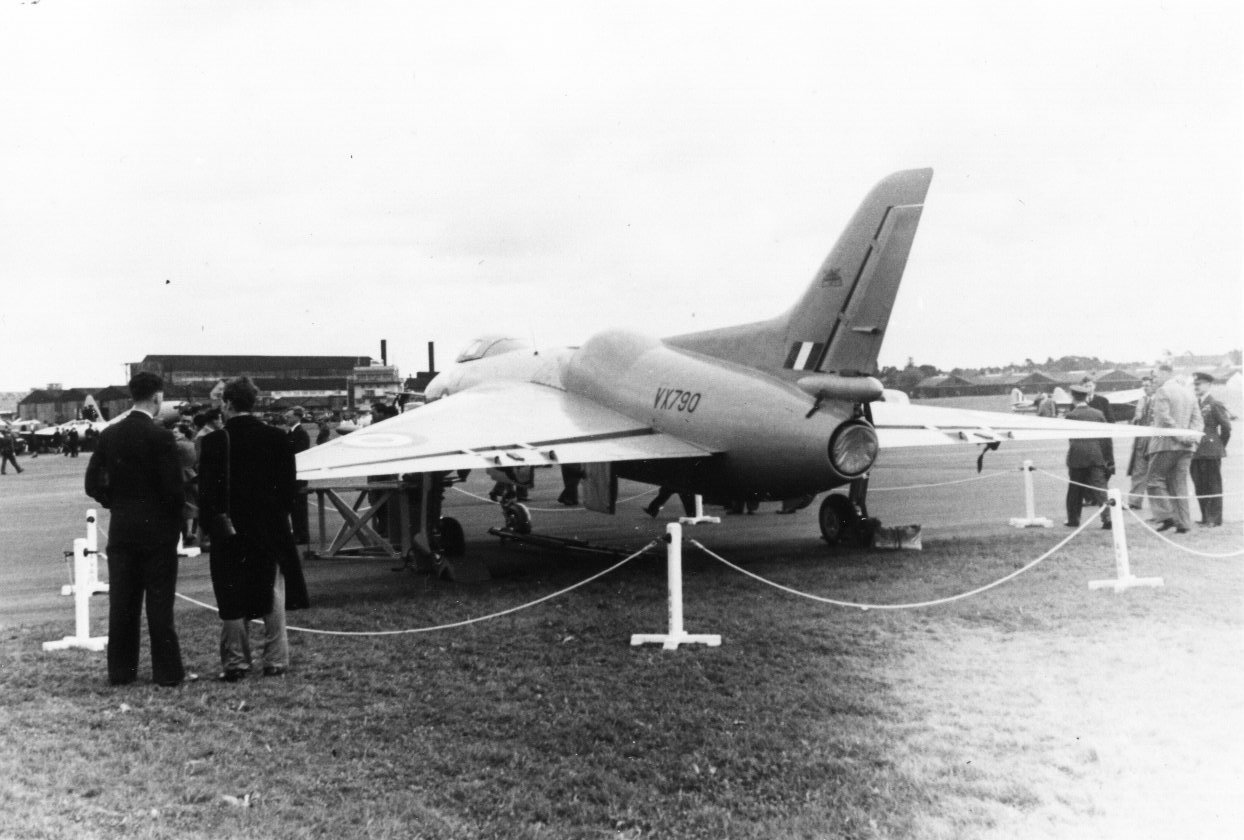- Avro 707
Infobox Aircraft
name = Avro 707
caption = Avro 707B "VX790" at Farnborourgh in 1951.
type =Experimental aircraft
manufacturer =Avro
designer = S.D. Davies (team leader)
first flight =4 September 1949
introduced =
retired = 1967
status = 3 aircraft survive in museums
primary user = Avro
more users =Royal Aircraft Establishment Australian Aeronautical Research Council
produced =
number built = 5
unit cost =
variants with their own articles =The Avro 707 was a British experimental aircraft built to test the tailess thick
delta wing configuration chosen for the Avro 698 jet bomber, later named the Vulcan. In particular, the low speed characteristics of such aircraft were not well known at the time. Aerodynamically it was a one-third scaled version of the Vulcan.Design and development
The 707 was a delta design, with a wing with about 500 sweep, without a horizontal tail on a fin with trailing edge sweep. The trailing edge of the wing carried two pairs of control surfaces: inboard elevators and outboard ailerons. Retractable airbrakes were provided above and below the wings.
The prototypes were ordered by the Ministry to specification E.15/48. The aircraft were produced quickly using a few components from other aircraft. The 707 programme provided valuable insights into the Vulcan's flight characteristics, most of the information coming from the second and third machines which flew before the Vulcan. All 707s were powered by a single Rolls Royce Derwent centrifugal turbojet. Five 707s were built altogether; the last three flew after the Vulcan's first flight on 30th August 1952.
The first, the Avro 707 first flew on 4th September 1949 but crashed less than a month later [ [http://www.davidsiddall.com/testflyingmemorial/1945onwards.htm Test Flying Memorial site] ] . The next machine, the 707B had a longer nose, different cockpit canopy (the earlier 707 had one from a Gloster Meteor), a wing of different (510) sweep and a longer nose wheel leg to provide the high angle of incidence required by deltas for landing and take off. The 707B was given the same dorsal engine intakes as the 707, though this was later modified to a N.A.C.A design. It first flew on 6th September 1950. Both these aircraft were built to test low speed characteristics.
The third aircraft, designated 707A was built for higher speed testing. Experience with the dorsal intakes of the "707B" had shown that as speed increased the cockpit induced turbulence interrupted intake airflow, so the intakes were moved to the wing roots. When the Vulcan appeared it looked very much like an enlarged 707A. Later, this 707A was used to to test the compound leading edge sweep subsequently used on all Vulcans. Though the Vulcan first prototype was now flying, a second 707A was built to speed the development programme, maiden fight on 20th February 1953.
The final variant was the two seat 707C, intended for delta handling familiarisation, maiden flight 1st July 1953.
The Avro 707s made memorable public appearances at the
Farnborough Airshow s in both 1952 and 1953; in 1952 the first prototype Vulcan flew with the 707s A & B; and in 1953 the four surviving 707s flew alongside the first two Vulcan prototypes.No 707s are now airworthy. Both examples of the Avro 707A variant survive. One is located at the
Museum of Science and Industry in Manchester , the other at the RAAF Museum inPoint Cook, Victoria .The single 707C two seater survives at theRAF Museum , Cosford nearWolverhampton .Operators
;AUS
*Royal Australian Air Force
*Australian Aeronautical Research Council;UK
*Royal Aircraft Establishment pecification
aircraft specifications
plane or copter?=plane
jet or prop?=jetcrew=1: pilot
length main=42 ft 4 in
length alt=12.90 m
span main=34 ft 2 in
span alt=10.41 m
height main=11 ft 7 in
height alt=3.53 m
area main=420 ft²
area alt=39 m²
empty weight main= lb
empty weight alt= kg
loaded weight main=9,500 lb
loaded weight alt=4,300 kg
useful load main=
useful load alt=
max takeoff weight main=
max takeoff weight alt=number of jets=1
engine (jet)=Rolls-Royce Derwent 8
type of jet=turbojet
thrust main=3,600 lbf
thrust alt=16 kNmax speed main=406 kt
max speed alt=467 mph, 747 km/h
cruise speed main=
cruise speed alt=
range main=
range alt=
ceiling main=
ceiling alt=
climb rate main=
climb rate alt=
loading main=22.6 lb/ft²
loading alt=110 kg/m²
thrust/weight=0.38ee also
aircontent
related=
*Avro Vulcan similar aircraft=
*Handley Page HP.88
*Boulton Paul P.111 References
External links
* [http://www.britishaircraft.co.uk/aircraftpage.php?ID=250 British Aricraft Directory entry]
* [http://www.aeroflight.co.uk/types/uk/avro/707/707.htm Aeroflight]
Wikimedia Foundation. 2010.
